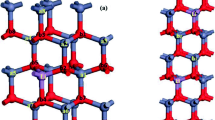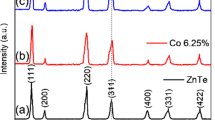Abstract
The effects of different doping proportions of Co doping and oxygen vacancies (VO) on the ferromagnetism of zinc oxide (ZnO) are controversial. To solve this problem, we investigated the effects of Co doping and point defects (VO, VZn, Hi, and Zni) on the ferromagnetism of ZnO through first-principle calculations by using generalized gradient approximation + U (GGA + U) under density functional theory. Results show that the closer the distance between Co and vacancies (VO or VZn), the lower the formation energy and the more stable the system will be. Co-doped ZnO with VO or VZn exhibits long-range ordered ferromagnetism and Curie temperature above the room temperature. Especially, Co-doped ZnO with VZn shows a half-metallic behavior, resulting in 100% conduction hole polarizability, which is highly beneficial for dilute magnetic semiconductors (DMSs) as a hole injection source. The ferromagnetism of Zn14CoO16 is caused by the double exchange effects among the electrons of the O–2p, Co–3d, and Zn–3d orbits mediated by the hole carriers after complexes were formed by the Co doping and Zn vacancy. Similarly, the origin of ferromagnetism in Zn15CoO15 is derived from the double exchange effects among the electrons of O–2p, Co–3d, and Zn–4s states mediated by the electron carriers after complexes were formed by the Co doping and O vacancy. In addition, the result shows that Co-doped ZnO with interstitial H (Hi) or Zn (Zni) is unfavorable for ferromagnetism and should be avoided experimentally.



Similar content being viewed by others
References
Ohno, H.: Making nonmagnetic semiconductors ferromagnetic. Sci. 281, 951–956 (1998)
Vijayaprasath, G., Murugan, R., Ravi, G., Mahalingam, T., Hayakawa, Y.: Characterization of dilute magnetic semiconducting transition metal doped ZnO thin films by sol–gel spin coating method. Appl. Surf. Sci. 313, 870–876 (2014)
Azab, A.A., Ateia, E.E., Esmail, S.A.: Comparative study on the physical properties of transition metal- doped (Co, Ni, Fe, and Mn) ZnO nanoparticles. Appl. Phys. A. 124(469), (2018)
Khan, R.Z., Araujo, C.I.L., Khan, T., Rahman, M.U., Rehman, Z.U., Khan, A., Ullah, B., Fashu, S.: Influence of oxygen vacancies on the structural, dielectric, and magnetic properties of (Mn, Co) Co-doped ZnO nanostructures. J. Mater. Sci: Mater. El. 29, 9785–9795 (2018)
Franco Jr., A., Pessoni, H.V.S., Ribeiro, P.R.T., Machado, F.L.A.: Magnetic properties of Co-doped ZnO nanoparticles. J. Magn. Magn. Mater. 426, 347–350 (2017)
Vijayaprasath, G., Murugan, R., Mahalingam, T., Ravi, G.: Comparative study of structural and magnetic properties of transition metal (Co, Ni) doped ZnO nanoparticles. J. Mater. Sci: Mater. El. 26, 7205–7213 (2015)
Venkatesan, M., Fitzgerald, C.B., Coey, J.M.D.: Thin films: unexpected magnetism in a dielectric oxide. Nature. 430, 630 (2004)
Xu, X., Xu, C., Dai, J., Hu, J., Li, F., Zhang, S.: Size dependence of defect-induced room temperature ferromagnetism in undoped ZnO nanoparticles. J. Phys. Chem. C. 116, 8813–8818 (2012)
Kittelstved, K.R., Liu, W.K., Gamelin, D.R.: Electronic structure origins of polarity-dependent high-TC ferromagnetism in oxide-diluted magnetic semiconductors. Nat. Mater. 5, 291–297 (2006)
Xing, G.Z., Lu, Y.H., Tian, Y.F., Yi, J.B., Lim, C.C., Li, Y.F., Li, G.P., Wang, D.D., Yao, B., Ding, J.: Defect-induced magnetism in undoped wide band gap oxides: zinc vacancies in ZnO as an example. AIP Adv. 1, 022152 (2011)
Khalid, M., Ziese, M., Setzer, A., Esquinazi, P., Lorenz, M., Hochmuth, H., Grundmann, M., Spemann, D., Butz, T., Brauer, G.: Phys. Rev. B: Defect-induced magnetic order in pure ZnO films. Condens. Matter Mater. Phys. 035331, 80 (2009)
Pan, F., Song, C., Liu, X.J., Yang, Y.C., Zeng, F.: Ferromagnetism and possible application in spintronics of transition-metal-doped ZnO films. Mater.Sci. Eng. R. 62, 1–35 (2008)
Lee, H.J., Jeong, S.Y., Cho, C.R., Park, C.H.: Study of diluted magnetic semiconductor: Co-doped ZnO. Appl. Phys.Lett. 81, 4020–4022 (2002)
Wang, D.D., Zhao, B., Qi, N., Chen, Z.Q., Kawasuso, A.: Vacancy-mediated ferromagnetism in Co-implanted ZnO studied using a slow positron beam. J. Mater. Sci. 52, 7067–7076 (2017)
Zhang, H.Y., Hao, W., Cao, Y.Q., Chang, X.F., Xu, M.X., Guo, X.L., Shen, K., Xiang, D.H., Xu, Q.Y.: Room temperature ferromagnetic Zn 0.98 Co 0.02 O powders with improved visible-light photocatalysis. RSC Adv. 6, 6761–6767 (2016)
Zhang, H., Cao, Y.Q., Yang, Z.X., Si, L.F., Zhong, W., Wu, D., Xu, M.X., Xu, Q.Y.: Enhanced room temperature ferromagnetism in Co-doped ZnO mediated by interstitial H. Mater. Lett. 89, 209–211 (2012)
Lina, Y.J., Wang, M.S., Liub, C.J., Huang, H.J.: Defects, stress and abnormal shift of the (002) diffraction peak for Li-doped ZnO films. Appl. Surf. Sci. 256, 7623–7627 (2010)
Liu, S.Y., Li, G.J., Jia, B.H., Tian, R.X., Wang, Q.: Effect of high magnetic field on magnetic properties of oxidized ZnO:Co film prepared with different growth models. AIP Adv. 7, 115122 (2017)
Valério, L.R., Mamani, N.C., Zevallos, A.O., Mesquita, A., Bernardi, M.I.B., Doriguetto, A.C., Carvalho, H.B.: Preparation and structural-optical characterization of dip-coated nanostructured Co-doped ZnO dilute magnetic oxide thin films. RSC Adv. 7, 20611–20619 (2017)
Ma, X.G., Wu, Y., Lv, Y.H., Zhu, Y.F.: Correlation effects on lattice relaxation and electronic structure of ZnO within the GGA+U formalism. J. Phys.Chem.C. 117, 26029–26039 (2013)
Shi, L.B., Qi, G.Q., Fei, Y.: Defect formation and magnetic properties of Co-doped ZnO nanowires. Nano. 8, 1350021 (2013)
Wang, S., Li, P., Liu, H., Li, J.B., Wei, Y.: The structure and optical properties of ZnO nanocrystals dependence on Co-doping levels. J. Alloy. Compd. 505, 362–366 (2010)
Sarsari, I.A., Salamati, H., Kameli, P., Razavi, F.S.: Optical, structural, and magnetic properties of ZnO:Co nanoparticles prepared by a thermal treatment of ball milled precursors. J. Supercond. Nov. Magn. 24, 2293–2298 (2011)
Patterson, C.H.: Role of defects in ferromagnetism in Zn1-xCoxO: a hybrid density-functional study. Phys. Rev. B. 74(144432), (2006)
Wardle, M.G., Goss, J.P., Briddon, P.R.: Theory of Li in ZnO: a limitation for Li-based p-type doping. Phys. Rev. B. 71(155205), (2005)
Na, P.S., Smith, M.F., Kim, K., Du, M.H., Wei, S.H., Zhang, S.B., Limpijumnong, S.: First-principles study of native defects in anatase TiO2. Phys. Rev. B. 73(125205), (2006)
Pickett, W.E., Moodera, J.S.: Half metallic magnets. Phys. Today. 54, 39–44 (2001)
Assadi, M.H.N., Zhang, Y.B., Li, S.: The role of unintentional hydrogen on magnetic properties of Co doped ZnO. AIP. Conf. Proc. 1399, 693–694 (2011)
Schwartz, D.A., Gamelin, D.R.: Reversible 300 K ferromagnetic ordering in a diluted magnetic semiconductor. ADV. Mater.A. 16, 2115–2119 (2004)
Lardjane, S., Merad, G., Fenineche, N., Billard, A., Faraoun, H.I.: Ab initio study of ZnCoO diluted magnetic semiconductor and its magnetic properties. J. Alloy. Compd. 551, 306–311 (2013)
Fan, J.C., Sreekanth, K.M., Xie, Z., Chang, S.L., Rao, K.V.: P-type ZnO materials: theory, growth, properties and devices. Prog. Mater. Sci. 58, 874–985 (2013)
Pan, Q.T., Huang, K., Ni, S.B., Yang, F., Lin, S.M., He, D.Y.: Photoluminescence and magnetism in Co-doped ZnO powder. J. Phys. D. Appl. Phys. 40, 6829–6833 (2007)
Sato, K., Dederichs, P.H., Katayama, Y.H.: Curie temperatures of III–V diluted magnetic semiconductors calculated from first principles. Europhys. Lett. 61, 403–408 (2003)
Devi, A.A.S., Roqan, I.S.: The origin of room temperature ferromagnetism mediated by Co–VZn complexes in the ZnO grain boundary. RSC Adv. 6, 50818–50824 (2016)
Simimol, A., Anappara, A.A., Weber, S.G., Chowdhury, P., Barshilia, H.C.: Enhanced room temperature ferromagnetism in electrodeposited Co-doped ZnO nanostructured thin films by controlling the oxygen vacancy defects. J. Appl. Phys. 117, 214310 (2015)
Funding
This work was supported by the National Natural Science Foundation of China (Grant nos. 61366008, 61664007) and the Science and Technology Major Project of Inner Mongolia Autonomous Region (2018-810).
Author information
Authors and Affiliations
Corresponding author
Additional information
Publisher’s Note
Springer Nature remains neutral with regard to jurisdictional claims in published maps and institutional affiliations.
Rights and permissions
About this article
Cite this article
Hou, Q.Y., Liu, Y.J. Effects of Co Doping and Point Defect on the Ferromagnetism of ZnO. J Supercond Nov Magn 32, 1135–1142 (2019). https://doi.org/10.1007/s10948-018-4987-y
Received:
Accepted:
Published:
Issue Date:
DOI: https://doi.org/10.1007/s10948-018-4987-y




